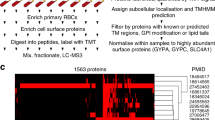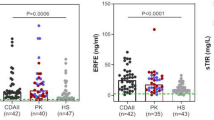Abstract
HEREDITARY ovalocytosis is common in some areas of Melanesia and South East Asia where malaria is endemic. These red cells resist invasion by malarial parasites in vitro1,2 and ovalocytic individuals are less parasitized than normal3. This has been attributed to the greater rigidity of ovalocytic red cells4,5. It has been suggested that South East Asian ovalocytosis results from the heterozygous presence of an altered membrane anion transporter (band 3)6,7. We have used the polymerase chain reaction to clone the abnormal band 3 complementary DNA from an ovalocytic of Indian origin8 and found two changes from the normal protein: a point mutation (Lys56-→Glu) and the deletion of the sequence AFSPQVLAA (residues 400–408), but no evidence for an N-terminal extension7. The deletion is also found in the abnor-mal band 3 of South East Asian ovalocytes9 and seems to be responsible for the unusual properties of the ovalocytic red cell. We show here that the membrane domain of the abnormal ovalocyte band 3 has a substantially altered structure and that the protein is defective in anion transport activity. The changed transport properties of the red cells may have a role in the reduced para-sitaemia of ovalocytic individuals.
This is a preview of subscription content, access via your institution
Access options
Subscribe to this journal
Receive 51 print issues and online access
$199.00 per year
only $3.90 per issue
Buy this article
- Purchase on Springer Link
- Instant access to full article PDF
Prices may be subject to local taxes which are calculated during checkout
Similar content being viewed by others
References
Kidson, C., Lamont, G., Saul, A. & Nurse, G. T. Proc. natn. Acad. Sci. U.S.A. 78, 5829–5832 (1981).
Hadley, T. et al. J. clin. Invest. 71, 780–782 (1983).
Cattani, J. A., Gibson, F. D., Alpers, M. P. & Crane, G. G. Trans. R. Soc. Trop. Med. Hyg. 81, 705–709 (1987).
Saul, A., Lamont, G., Sawyer, W. H. & Kidson, C. J. Cell. Biol. 98, 1348–1354 (1984).
Mohandas, N., Lie-Injo, L. E., Friedman, M. & Mak, J. W. Blood 63, 1385–1392 (1984).
Liu, S. C. et al. New Engl, J. Med. 323, 1530–1538 (1990).
Jones, G. L., Edmundsen, H. M. Wesche, D. & Saul, A. Biochim. biophys. Acta 1096, 33–40 (1991).
Schofield, A. E. et al. J. molec. Biol. (in the press).
Tanner, M. J. A., Bruce, L., Martin, P. G., Rearden, D. M. & Jones, G. L. Blood 78, 2785–2786 (1991).
Tanner, M. J. A., Martin, P. G. & High, S. Biochem. J. 256, 703–712 (1988).
Kopito, R. R. & Lodish, H. F. Nature 316, 234–238 (1985).
Cabantchik, Z. I., Kutner, S., Krugliak, M. & Ginsburg, H. Molec. Pharmac. 23, 92–99 (1983).
Wagner, S., Vogel, R., Lietzke, R., Koob, R. & Drenckhahn, D. Am. J. Physiol. 253, F213–F221 (1987).
Weith, J. O., Anderson, O. S., Brahm, J., Bjerrum, P. J. & Borders, C. L. Phil. Trans. R. Soc. B 299, 383–399 (1982).
Amato, D. & Booth, P. B. Papua New Guinea Med. J. 20, 26–32 (1977).
Serjeantson, S., Bryson, K., Amato, D. & Babona, D. Hum. Genet 37, 161–167 (1977).
Laemmli, U. K. Nature 227, 680–681 (1970).
Janas, T., Bjerrum, P. J., Brahm, J. & Weith, J. O. Am. J. Physiol. 257, C601–C606 (1989).
Pimplikar, S. W. & Reithmeier, R. A. F. J. biol. Chem. 261, 9770–9778 (1986).
Shearman, M. S. & Halestrap, A. P. Biochem. J. 223, 673–676 (1984).
Halestrap, A. P. Biochem. J. 156, 193–207 (1976).
Author information
Authors and Affiliations
Rights and permissions
About this article
Cite this article
Schofield, A., Reardon, D. & Tanner, M. Defective anion transport activity of the abnormal band 3 in hereditary ovalocytic red blood cells. Nature 355, 836–838 (1992). https://doi.org/10.1038/355836a0
Received:
Accepted:
Issue Date:
DOI: https://doi.org/10.1038/355836a0
This article is cited by
-
The band 3–ankyrin multiprotein complex comes in from the cold
Nature Structural & Molecular Biology (2022)
-
The influence of host genetics on erythrocytes and malaria infection: is there therapeutic potential?
Malaria Journal (2015)
-
Alterations in band 3 protein and anion exchange in red blood cells of renal failure patients
Molecular and Cellular Biochemistry (2005)
-
Twenty seven nucleotide deletion within exon 11 of the erythrocyte band 3 gene in Indonesian ovalocytosis
Japanese Journal of Human Genetics (1994)
Comments
By submitting a comment you agree to abide by our Terms and Community Guidelines. If you find something abusive or that does not comply with our terms or guidelines please flag it as inappropriate.



